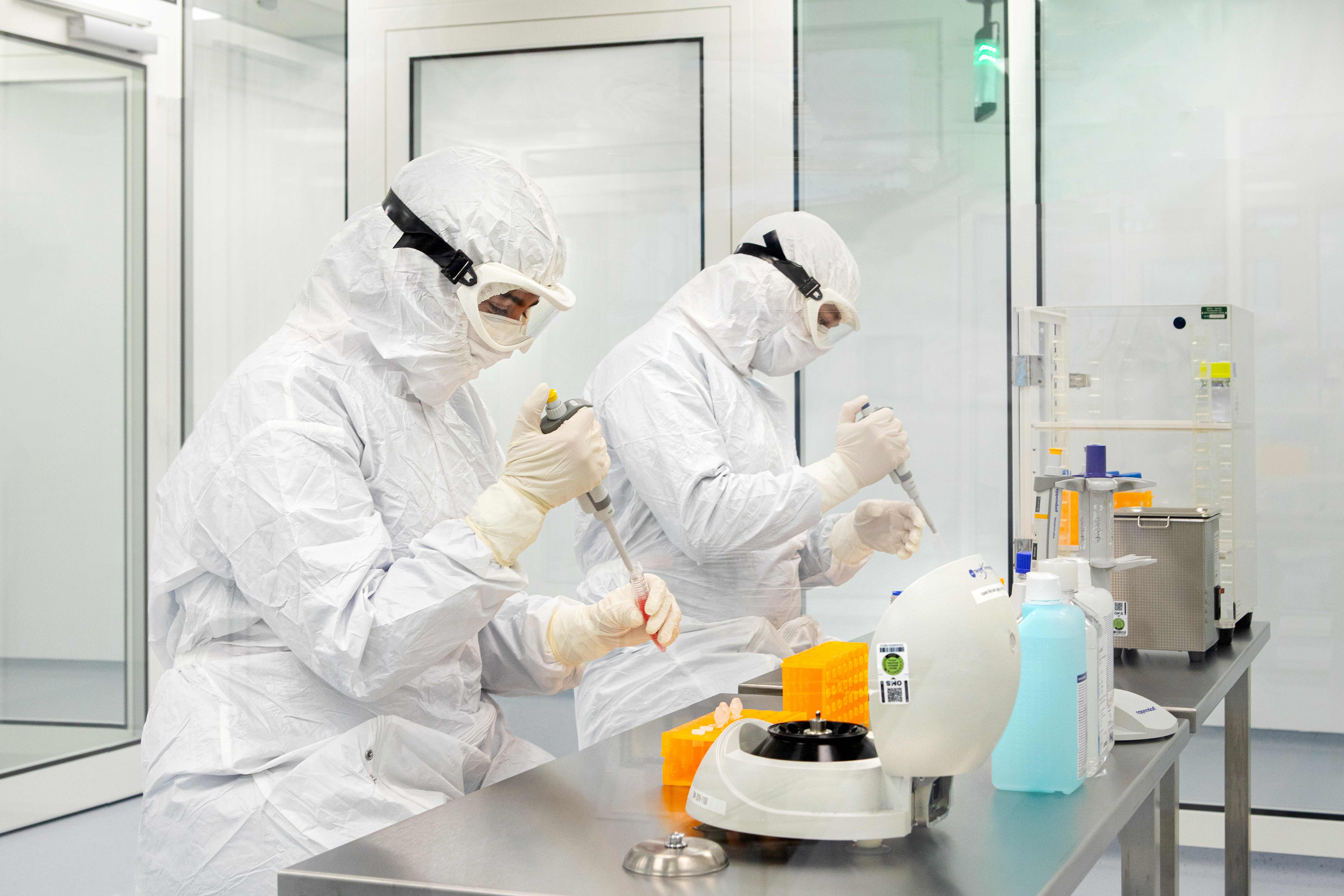Translational research in the fiT
Translational research is a necessary and mandatory scientific phase for the development of new biomedical or pharmaceutical approaches, which is being performed to progress basic research into a first clinical use in humans.
In contrast to basic research, which is focused on a single research result, translational research is directed towards a clearly defined therapeutic or diagnostic target based on a comprehensive set of performance criteria which need to be fulfilled to convert the basic research into a safe, effective and high-quality product for human use.

Biomedical and pharmaceutical innovations in translational research
To promote and facilitate translational research in an academic environment, the fiT works towards closing the existing gap between basic research and translational research by supporting researchers with guidance and infrastructure through the translational research phase according to globally accepted safety as well as quality standards for first-in-human trials of new therapeutic developments.
Biomedical and pharmaceutical innovations that must follow the path of translational research include:
- Medical Devices
Medical devices serve different healthcare purposes but differ from drug products (also referred as medicinal products) in that they exhibit no pharmacological effect. Instead, medical devices act by mechanical or physical means in or on the body to achieve their health benefit. According to the Medical Device Regulation (MDR), a medical device is defined as any instrument, apparatus, appliance, software, implant, reagent, material, or other article intended by the manufacturer to be used, alone or in combination, for human beings for specific medical purposes. It does not achieve its primary effect through pharmacological, immunological, or metabolic means. Medical devices are certified and marked with a CE number. An example of a medical device is a pacemaker, which is commonly implanted to treat cardiac arrythmias by regulating the hearts’ rhythm with electric impulses when needed.
- In-Vitro Diagnostics
In vitro diagnostics are highly sensitive and selective healthcare tools that are designed for use in routine patient care. According to the in vitro diagnostics regulation (IVDR), an in vitro diagnostic is defined as a medical device that is intended by the manufacturer to examine samples derived from the human body and provide relevant diagnostic information. This information may include, but is not limited to, physiological or pathological conditions, predispositions to disease, anticipated effect of treatments, and therapy monitoring. In vitro diagnostics are certified and marked with a CE number similar to medical devices. As such, in vitro diagnostics should not be confused with in-vitro models used in basic research.
The COVID-19 rapid test and the COVID-19 PCR test are examples of in vitro diagnostics for detecting the virus using a human saliva sample, whereby the rapid test is used for the immediate detection of an infection and the PCR test for the specific detection, monitoring and spread of pandemic virus mutations.
- Medicinal products for human use
Medicinal products are substances that are used to treat diseases, correct or modify physiological functions by exerting a pharmacological, immunological, or metabolic action, to relieve complaints, or to prevent such diseases or complaints in the first place. The substances can act both within or on the body. Atorvastatin is such a medicinal drug product, that is orally applied as a blood lipid lowering drug to prevent arteriosclerosis and cardiovascular diseases.
Any substance that is systemically administered to enable a medical diagnosis is also considered a medicinal product. One example for this are contrast agents used to make anatomic structures better visible in medical imaging procedures (radiography, magnetic resonance imaging, sonography).
- Advanced Therapeutic Medicinal Products
Advanced therapy medicinal products (ATMPs) are medicines for human use that are based on genes, tissues, or cells and defined in Europe by the regulation EU 1394/2007.
Different types or classes of ATMP products are described within the regulatory frameworks. The specific preclinical studies and requirements of a new project for the use in humans, are derived from a thorough risk profiling of the new cell- or gene-technology used as well as its mode of administration.
Chimeric antigen receptor (CAR)-T cell therapy is an example for an ATMP, as it involves the modification of patient-own T-cells to better recognize and attack cancer cells, which are then reintroduced into the patients’ body to treat the disease.

Development steps of translational scientific research programs
Specific translational scientific research programs with defined development steps apply to these different classes of innovation. Translational science and research activities usually consist of the following programs in accordance with the applicable regulations of Good Laboratory Practice (cGLP) / Good Manufacturing Practice (cGMP):
- Definition of the specific use or indication and the required non-clinical and clinical performance criteria of the prototype/product including stakeholders and their requirements
- A comprehensive set of preclinical safety assessment including literature research, in vitro and in vivo animal studies
- Prototype qualification through a product and process development program to consistently achieve the defined specification
- Complete documentation of the preclinical and prototype qualification research program including a risk mitigation plan
- Manufacturing of the prototype in a cGMP compliant facility and approval by a Qualified Person
Legal and regulatory framework of healthcare products for human use
Healthcare products for human use are legally regulated products by authorities like the European Medicines Agency (EMA), the Food and Drug Administration (FDA), or other notified bodies designated by a government. Such products can only be used in humans and marketed after regulatory approval or certification by a competent institution.
Before development of a health product begins, the applicable legal and regulatory path must be clarified. Each of the four regulatory pathways, cover specific health products. In Europe these are:
- Medical Device Regulation (MDR) (Regulation EU/2017/745)
- In Vitro Diagnostic Regulation (IVDR) (Regulation EU/2017/746)
- Medicinal Products for human use (Directive 2001/83/EC and Directive 2009/35/EC)
- Advanced Therapeutic Medicinal Products (Regulation EU/1394/2007)
You can find out how the translation of a clinical trial product in fiT would work in this exemplary project film.
